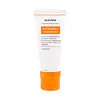What's inside
What's inside
 Key Ingredients
Key Ingredients

No key ingredients
 Benefits
Benefits

 Concerns
Concerns

 Ingredients Side-by-side
Ingredients Side-by-side

Water
Skin ConditioningPotassium Cocoyl Hydrolyzed Oat Protein
Skin ConditioningGlycerin
HumectantCocamidopropyl Betaine
CleansingPotassium Cocoyl Glycinate
PEG-120 Methyl Glucose Dioleate
EmulsifyingButylene Glycol
HumectantHippophae Rhamnoides Extract
MaskingXanthan Gum
EmulsifyingHouttuynia Cordata Extract
Skin ConditioningPanthenol
Skin ConditioningSodium PCA
HumectantDipotassium Glycyrrhizate
HumectantChlorphenesin
AntimicrobialAllantoin
Skin ConditioningDisodium EDTA
Capsicum Annuum Extract
MaskingDaucus Carota Sativa Extract
PerfumingWater, Potassium Cocoyl Hydrolyzed Oat Protein, Glycerin, Cocamidopropyl Betaine, Potassium Cocoyl Glycinate, PEG-120 Methyl Glucose Dioleate, Butylene Glycol, Hippophae Rhamnoides Extract, Xanthan Gum, Houttuynia Cordata Extract, Panthenol, Sodium PCA, Dipotassium Glycyrrhizate, Chlorphenesin, Allantoin, Disodium EDTA, Capsicum Annuum Extract, Daucus Carota Sativa Extract
Water
Skin ConditioningCocamidopropyl Betaine
CleansingGlycerin
HumectantDecyl Glucoside
CleansingPotassium Cocoyl Hydrolyzed Oat Protein
Skin ConditioningPEG-120 Methyl Glucose Dioleate
EmulsifyingButylene Glycol
HumectantRosa Damascena Flower Water
MaskingAllantoin
Skin ConditioningCucumis Sativus Fruit Extract
EmollientRose Flower Oil
MaskingGlycine Soja Seed Extract
Skin ConditioningHelianthus Annuus Seed Oil
EmollientTocopheryl Acetate
AntioxidantSodium Hyaluronate
HumectantPhenoxyethanol
PreservativePPG-13-Decyltetradeceth-24
EmulsifyingPotassium Chloride
Polysorbate 20
EmulsifyingDisodium EDTA
Citric Acid
BufferingPentylene Glycol
Skin Conditioning1,2-Hexanediol
Skin ConditioningBeeswax
Emulsion StabilisingEthylhexylglycerin
Skin ConditioningOlea Europaea Leaf Extract
PerfumingGlyceryl Laurate
EmollientGlyceryl Caprylate
EmollientWater, Cocamidopropyl Betaine, Glycerin, Decyl Glucoside, Potassium Cocoyl Hydrolyzed Oat Protein, PEG-120 Methyl Glucose Dioleate, Butylene Glycol, Rosa Damascena Flower Water, Allantoin, Cucumis Sativus Fruit Extract, Rose Flower Oil, Glycine Soja Seed Extract, Helianthus Annuus Seed Oil, Tocopheryl Acetate, Sodium Hyaluronate, Phenoxyethanol, PPG-13-Decyltetradeceth-24, Potassium Chloride, Polysorbate 20, Disodium EDTA, Citric Acid, Pentylene Glycol, 1,2-Hexanediol, Beeswax, Ethylhexylglycerin, Olea Europaea Leaf Extract, Glyceryl Laurate, Glyceryl Caprylate
 Reviews
Reviews

Ingredients Explained
These ingredients are found in both products.
Ingredients higher up in an ingredient list are typically present in a larger amount.
Allantoin is a soothing ingredient known for its protective and moisturizingg properties. Because of this, it is often added to products with strong active ingredients.
Studies show higher concentrations of this ingredient can promote wound healing.
Though it can be derived from the comfrey plant, allantoin is produced synthetically for cosmetic products to ensure purity.
Learn more about AllantoinButylene Glycol (or BG) is used within cosmetic products for a few different reasons:
Overall, Butylene Glycol is a safe and well-rounded ingredient that works well with other ingredients.
Though this ingredient works well with most skin types, some people with sensitive skin may experience a reaction such as allergic rashes, closed comedones, or itchiness.
Learn more about Butylene GlycolCocamidopropyl Betaine is a fatty acid created by mixing similar compounds in coconut oil and dimethylaminopropylamine, a compound with two amino groups.
This ingredient is a surfactant and cleanser. It helps gather the dirt, pollutants, and other impurities in your skin to be washed away. It also helps thicken a product and make the texture more creamy.
Being created from coconut oil means Cocamidopropyl Betaine is hydrating for the skin.
While Cocamidopropyl Betaine was believed to be an allergen, a study from 2012 disproved this. It found two compounds in unpure Cocamidopropyl Betaine to be the irritants: aminoamide and 3-dimethylaminopropylamine. High-grade and pure Cocamidopropyl Betaine did not induce allergic reactions during this study.
Learn more about Cocamidopropyl BetaineDisodium EDTA plays a role in making products more stable by aiding other preservatives.
It is a chelating agent, meaning it neutralizes metal ions that may be found in a product.
Disodium EDTA is a salt of edetic acid and is found to be safe in cosmetic ingredients.
Learn more about Disodium EDTAGlycerin is already naturally found in your skin. It helps moisturize and protect your skin.
A study from 2016 found glycerin to be more effective as a humectant than AHAs and hyaluronic acid.
As a humectant, it helps the skin stay hydrated by pulling moisture to your skin. The low molecular weight of glycerin allows it to pull moisture into the deeper layers of your skin.
Hydrated skin improves your skin barrier; Your skin barrier helps protect against irritants and bacteria.
Glycerin has also been found to have antimicrobial and antiviral properties. Due to these properties, glycerin is often used in wound and burn treatments.
In cosmetics, glycerin is usually derived from plants such as soybean or palm. However, it can also be sourced from animals, such as tallow or animal fat.
This ingredient is organic, colorless, odorless, and non-toxic.
Glycerin is the name for this ingredient in American English. British English uses Glycerol/Glycerine.
Learn more about GlycerinPeg-120 Methyl Glucose Dioleate is used to improve texture and stability of a product. It is sugar based and helps thicken a product.
Once applied, it also creates a thin film to trap moisture in. This helps keep your skin hydrated.
This ingredient is the polyethylene glycol ether of the diester of oleic acid and methylglucose. The 120 represents an average of 120 moles of ethylene oxide.
There is limited research on this ingredient, although it is considered safe to use in skincare products.
Learn more about PEG-120 Methyl Glucose DioleateWe don't have a description for Potassium Cocoyl Hydrolyzed Oat Protein yet.
Water. It's the most common cosmetic ingredient of all. You'll usually see it at the top of ingredient lists, meaning that it makes up the largest part of the product.
So why is it so popular? Water most often acts as a solvent - this means that it helps dissolve other ingredients into the formulation.
You'll also recognize water as that liquid we all need to stay alive. If you see this, drink a glass of water. Stay hydrated!
Learn more about Water